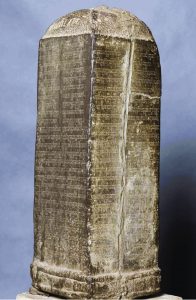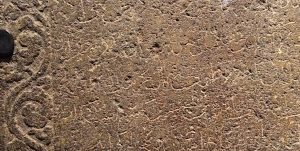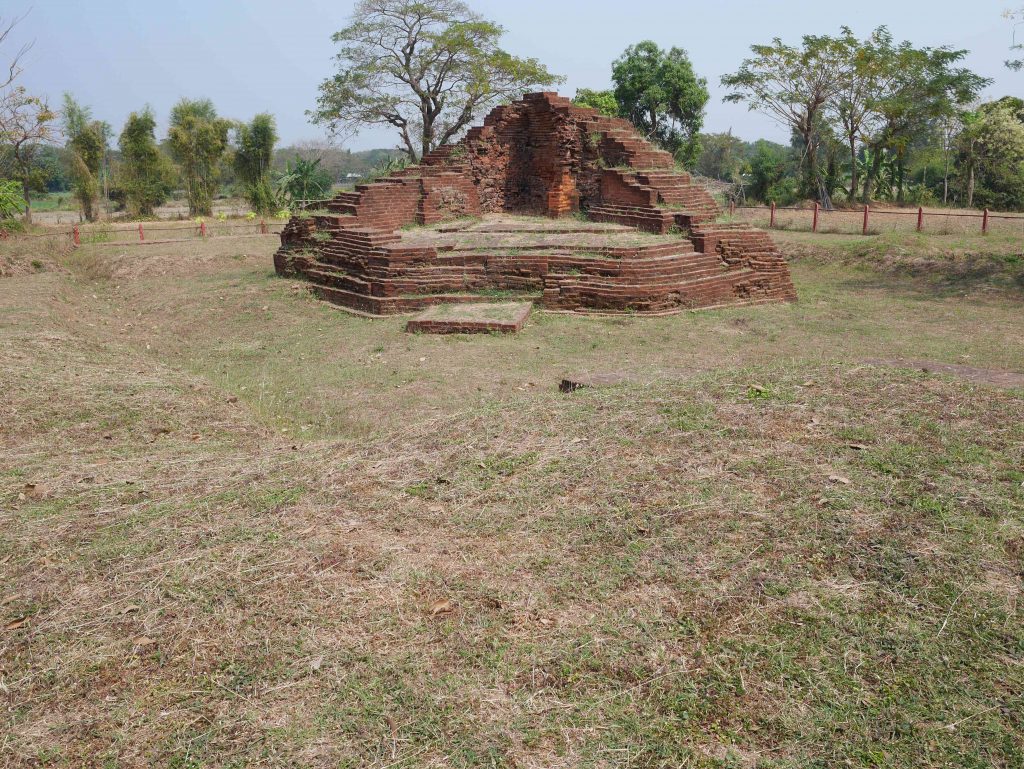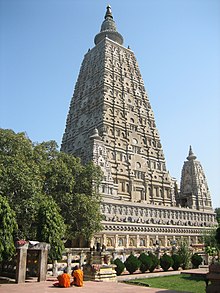Stele of Vằt Thlĕṅ
Inscription K.1 (site: Vằt Thlĕṅ, area: Châu Đốc) Śaka 6th-7th century = CE 578-777
(1) vā ta śivadeva saṃ ta kurāk kandāy cap vā kandos 1 ku tai dau
(2) jvan ta mratāñ kloñ jeṣṭhapura kāla kloñ bhavapura ‘atmaiy
(3) ‘ācāryya īśānadatta dau ka dhāra ge ta mratāñ ge tel poñ
(4) kumāraśānti ta kloñ ge ptā ta ‘nak poñ pre ‘ācāryya īśāna-
(5) -datta loḥ ge man supratiṣṭha vraḥ kamratāṅ ‘añ śrīśaṅka-
(6) -ranārāyana poñ oy ge ta vraḥ vnāk nuḥ upakalpa mratāñ
(7) kloñ bhavapura pre tāṅ spun tāṅ bho ‘ācāryya śilabhadra ‘mac
(8) vnāk kanloṅ kurāk kandāy pras ni poñ śivadeva kanmoy kaṃton
(9) poñ kumāraśānti paṅtiṅ kti mratāñ kloñ bhavapura pre mok
(10) oy ge ta vraḥ kaṃmratāṅ ‘añ śrīśaṅkanārāyana ai cmoṅ
(11) vā kandos 1 ku tai 1 kon ku vā jloy 1 ku juṅ tṅā 1 vā so 1 ku ‘antis 1 ku kaṃ’el
(12) vā trok 1 vā jīva 1 ku dhuli 1 vā vinita 1
(13) sre raloṅ ruṅ ‘aṃvi tṅai luc pu yoñ loḥ teṃ cikkan ‘aṃvi
(14) ñaṅ travaṅ taṅ dallan loḥ tṅai luc travaṅ īśvarakumāra ti le kyel
(15) gui raloṅ ver tṅai ket travaṅ taṅ dal man loḥ ta poñ pravara…..
(16) ‘aṃvi teṃ saṅnāyana loḥ ta sre vraḥ kloñ vā candravira ‘aṃvi ..
(17) …va taṅ dal ñaṅ plu loḥ travaṅ ver ñaṅ plu pi…..
(18) … kyel guha loḥ travaṅ taṅ …..
(19) travaṅ kvaḥ ‘añ sin loḥ travaṅ poñ vidyābhadra d…..
(20) ai karoṃ kyel gui pāk raṃloṅ vera ple pi kañje …..
(21) sre ai tel tṅai ket teṃ kadaṃ raloṅ piyy le kyel …..
(22) sre ‘aṃvi teṃ ransi… pi sre man kloñ jleṅ lak ta vraḥ loḥ …..
(23) kloñ gann loḥ travaṅ poñ śiladeva pramoy māss ‘aṃr…..
(24) ‘aṃvi travaṅ va tvellan daṅ gui raloṅ kandinn ‘aṅ ..ṭnall saṃ lo…
(25) ñaṅ gui sre kloñ ci mratāṅ tṅai ket gui kyoy tvākk daṃnuñ loḥ gui
(26) ….ṇ sare 1…..
Say Fong : Stèle des hôpitaux de Jayavarman VII

Say Fong (Laos). Stèle de Jayavarman VII (après Lorrillard 2018).
Say Fong : Inscription of Jayavarman VII
Inscription with information on Hospital Networks in ancient Cambodia.
OBPYU19 Stela from Hpayahtaung Pagoda
Sri Ksetra, Pyay. Brick structure the Payahtaung complex. The present object was found near here in March 1999.
PYU19 Stela Inscription from Hpayahtaung Pagoda
PYU19 Stela from Hpayahtaung Pagoda.
OBPYU11 Stone Stela from near the Tharaba Gate
Tharaba Gate, Bagan, where the stone stela (OBPYU11) was found.
IN03151 Galle Trilingual Stele – Persian Inscription

Galle (Sri Lanka). Stele of Zheng He (鄭和), detail of Persian portion. (Zenodo).
The inscription is engraved on a stone slab discovered in 1911 by H. F. Tomalin, the Provincial Engineer at Galle, in a culvert near the turn to Cripps Road within that town and afterwards moved to the Colombo Museum. The slab features inscriptions in three different languages, enclosed within a floral border: Tamil (top-left, IN03150), Persian (bottom-left) and Chinese (right, IN03152). The Persian inscription is dealt with here.
Following the discovery of the slab, the Chinese inscription was successfully transcribed and translated by Edmund Backhouse. However, Rao Bahadur H. Krishna Sastri (Assistant Superintendent for Epigraphy, Madras) and J. Horrovitz (Epigraphist for Moslem Inscriptions in India) failed in their efforts to decipher the Tamil and Persian texts respectively. Sometime later, the Tamil inscription was transcribed and translated for the third volume of Epigraphia Zeylanica (1933: 331–341) by Senarath Paranavitana, who benefitted from having access to Backhouse’s translation of the Chinese text. The Persian inscription is badly damaged but Khwaja Muhammad Ahmad of the Archaeological Department of H. E. H. the Nizam’s Dominions was able to compile a text and translation of the legible portion, which was published in 1933 as an appendix (Appendix B) to Paranavitana’s account of the Tamil inscription.
Following the discovery of the slab, the Chinese inscription was transcribed and translated by Edmund Backhouse. Like the Tamil inscription, it is dated in the second month of the seventh year of Yongle (永樂), the Chinese emperor whose reign began in 1403. The text features praise and offerings dedicated by the Chinese emperor, through his envoys Ching-Ho and Wang Ch’ing Lien, to the Buddha. The other two inscriptions on the slab feature similar lists of offerings but the beneficiary is different in each case, being a Hindu cult deity in the Tamil text and an Islamic saint or shrine in the Persian. It therefore appears that, when the Chinese arrived in Sri Lanka, they made gifts of equal value to several different religious traditions of the region and registered these gifts on the same stele.
Persian inscription of Jahāngīr dated AH 1027
Persian inscription (INAP00003) of Jahāngīr dated AH 1027 carved on a marble slab (OBAP00003).
OBCH0006 Bodhgayā stone slab with a seated Buddha, Mārīcī and a fragmentary Chinese inscription
Bodhgayā (बोधगया, often Bodh Gaya, Bihār).
OBCH0006 Bodhgayā stone slab with a seated Buddha, Mārīcī and a fragmentary Chinese inscription (INCH0006). The present location of the original is not recorded (07/2019).




